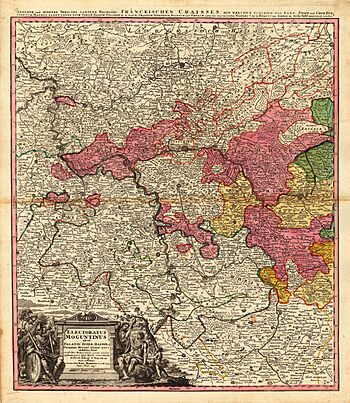Electorate of Mainz facts for kids
Quick facts for kids
Prince-Archbishopric of Mainz
|
|||||||||||||||||
|---|---|---|---|---|---|---|---|---|---|---|---|---|---|---|---|---|---|
| 780–1803 | |||||||||||||||||

Location of the Archbishopric of Mainz, 1729
|
|||||||||||||||||
| Status | State of the Holy Roman Empire | ||||||||||||||||
| Capital | Mainz | ||||||||||||||||
| Common languages | German | ||||||||||||||||
| Religion | Catholic Church | ||||||||||||||||
| Government | Ecclesiastical principality | ||||||||||||||||
| Prince-elector and Archbishop | |||||||||||||||||
|
• 754–786
|
Lullus (first) | ||||||||||||||||
|
• 1802–1803
|
Karl Theodor von Dalberg (last) | ||||||||||||||||
| Historical era | |||||||||||||||||
|
• Gained territory, elevated to archbishopric
|
780 | ||||||||||||||||
|
• Gained territory
|
983 | ||||||||||||||||
| 1251 | |||||||||||||||||
|
• Mainz made Free City
|
1242–1462 | ||||||||||||||||
|
• Republic of Mainz
|
18 March – 23 July 1793 | ||||||||||||||||
| 17 October 1797 | |||||||||||||||||
|
• German Mediatisation
|
1803 | ||||||||||||||||
|
|||||||||||||||||
| Today part of | Germany | ||||||||||||||||
The Electorate of Mainz was a very important and powerful part of the Holy Roman Empire. It was led by the Archbishop-Elector of Mainz. This person was a high-ranking church leader.
The Archbishop-Elector of Mainz was also known as the Primate of Germany. This was an honorary title, meaning they were seen as the top religious leader in Germany. There were only two other church leaders in the Empire who had the special power to help choose the Emperor: the Archbishops of Cologne and Trier.
The Archbishop-Elector of Mainz also held a very important political job. They were the Archchancellor of Germany. This meant they were like a chief minister for the Emperor. They were considered the most important ruler among all the church and non-church princes in the Empire, second only to the Emperor himself. They played a big role in helping the different parts of the Empire communicate with the Emperor.
History of the Electorate of Mainz
The city of Mainz was once a Roman provincial capital called Moguntiacum. A bishop's seat was set up there in ancient Roman times. The first known Bishop of Mainz was Martinus in 343 AD.
Mainz became very important in both church and government matters around 747 AD. This was when St. Boniface became the bishop. His successor, Lullus, helped make Mainz an archdiocese in 781 AD. An archdiocese is a very important church region led by an archbishop.
The Electorate of Mainz was not one single piece of land. It included several separate areas. These included lands near the city of Mainz, areas along the Main River, and regions like Eichsfeld and Erfurt.
It's important to know that the land ruled by the Archbishop (the "electorate") was different from the larger church area (the "archdiocese"). The archdiocese was the spiritual area where the archbishop had religious authority. The archdiocese of Mainz was the largest church province in Germany during the early modern age.
In 1802, the Electorate of Mainz lost its special status. This happened during a time of big changes in Germany. Many church lands and powers were taken away. The last elector, Karl Theodor von Dalberg, had to move his seat to Regensburg.
Mainz lost its lands west of the Rhine River to France. Other parts went to different German states. Dalberg kept a small area called Aschaffenburg. Later, he combined several areas to form the new Grand Duchy of Frankfurt in 1810.
After Dalberg resigned in 1813, the Congress of Vienna in 1815 divided his territories. They were split among different kingdoms and duchies in Germany.
Today, the Roman Catholic Diocese of Mainz still exists. It was founded in 1802. It covers parts of modern-day Germany. This modern diocese has kept some old traditions, like allowing its cathedral chapter to elect a new bishop.
Images for kids
See also
- Electorate of Cologne
- Electorate of Trier









